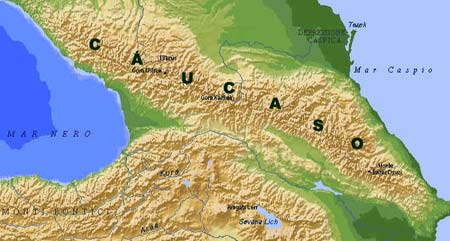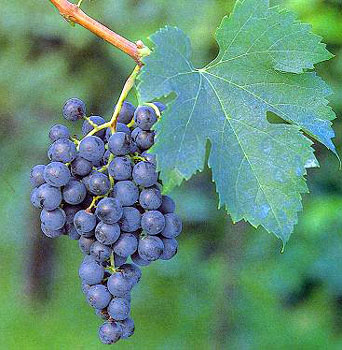
Diciamo la verità . E’ difficilissimo mangiare e/o bere non dico bene, ma decentemente in posti come Venezia, a meno di non mettere in conto cifre importanti.

Diciamo la verità . E’ difficilissimo mangiare e/o bere non dico bene, ma decentemente in posti come Venezia, a meno di non mettere in conto cifre importanti.

Suggestione n°1
Durante il Vinitaly ho assaggiato i vini della cantina georgiana Badagoni. Parli di Caucaso e pensi alle anfore. E invece tutti i vini rossi (a base Saperavi) e bianchi (a base Rkatsiteli) sono vinificati in acciaio e la supervisione tecnica è affidata all’enologo italiano Donato Lanati, fondatore dei laboratori ENOSIS. Dimenticavo. Il vino più convincente per correttezza dei profumi e rotondità del gusto era proposto agli operatori (enoteche ecc.) a 1.80 euro la bottiglia.
by Martin Field
Indigestion, wine and sin
As a typical big eater and drinker, it’s hardly any wonder that I’ve suffered for years from chronic indigestion. I love highly tannic reds, white wines acidic enough to strip the duco from a car, smoky shots of single malt whisky, chili-laden food, and all that stomach attacking stuff.
So how has my doctor treated this indigestion so far? Never bothered mentioning it to her. Due no doubt to my early Catholic upbringing, my subconscious figured that the alimentary discomfort was spiritual vengeance for my sins of gluttony. I learned to live with it.
Balloon breath
Then Lucy went to the doc and complained about her ongoing indigestion symptoms. The doc gave her a capsule to swallow and 10 minutes later had her blow into a silver balloon. The balloon, complete with breath sample, then went off to the pathology lab for testing. The diagnosis? Indigestion caused by the bacterium Helicobacter Pylori.
She was prescribed a one-week course of Nexium – a triple dose regime comprising an acid suppressant and two different antibiotics. Four weeks later, she took the breath test again and the doc pronounced her cured.
HP source – Catching acid
Mmmm. Maybe I was also suffering from the dreaded H.P. Indeed, the doc’s fact sheet stated that the bug could be transmitted from person to person. So it was off to the clinic for some balloon blowing.
Yep, it turned out that my stomach lining also harboured the dreaded bug. The doc prescribed the same treatment; with similar success. I still eat and drink prodigiously but no longer experience the dreaded ‘heartburn’. More importantly, I’ve minimised the risk of reinfecting the family.
Prize winners
The 2005 Nobel Prize for medicine went to the two Australians, Barry Marshall and Robin Warren, who discovered H. pylori’s role in causing peptic ulcers, gastritis and various chronic stomach inflammations – some of which can lead to cancer. They also developed non-invasive diagnostic techniques and a cure – for which we should all be extremely thankful.
According to one H. pylori fact sheet I read, it is estimated that up to half the human population may carry the bacterium, although many carriers are asymptomatic; that is, they display no symptoms.
Gulper? Slurper? Chronic indigestion? Ask your doc for a silver balloon.
by Martin Field
How the rich live
A long while back, we had a big New Year’s Eve party at the beach shack. It was one of those turns where everyone mucked in and shared.
One very wealthy couple (luxury holiday house at Portsea Back Beach etc.) brought along two bottles of beer and a can of four-bean mix. ‘Just put the beans in a bowl with some dressing,’ they said graciously. Later we learned that they’d borrowed the two bottles of beer from another guest on the way in. ‘Just so it looks like we’re bringing something.’
We drank the beer and kept the can of beans for years as a conversation piece.

Dopo alcuni giorni di ritardo, dovuti agli impegni di molti blogger legati al passato Vinitaly, eccoci giunti alla fine di questa tappa.
Pensavo che non ci sarebbe stata storia a favore del Pinot Nero, e invece lo scontro è finito in perfetta parità : 6 a 6!!
Per quanto riguarda i vini Italiani solamente una bottiglia è risultata prodotta fuori dal Triveneto, segno evidente che queste terre sono unanimemente riconosciute come le più adatte alla coltivazione di questi vitigni, desiderosi di climi freschi.
Fiorenzo Sartore (Diario Enotecario) e Roberto Giuliani (Esalazioni Etiliche) hanno scelto senza esitazione il Pinot Nero Sant’Urbano Villa Barthenau di Hofstatter nei millesimi 2001 e 1995 rispettivamente. Pare che il vino sia piaciuto molto e siano volati punteggi vicini a 90/100.
Filippo Ronco invece ha due grandi amori; uno è il Pinot Nero Riserva Mazzon Gottardi 2002 (TigullioVino Weblog), con cui accompagna spesso i momenti più belli…
A Slawka G. Scarso la lunga persistenza retro olfattiva del Pinot Nero Selyet 2003 Laymburg (Nanopausa) ha ispirato un bel haiku, mentre a Joan Gòmez Pallarès l’AD FINES 2001 (De Vinis Cibisque) ha ricordato addirittura un grande Barolo.
Infine Pier Francesco Lisi ha scelto (naturalmente) un biologico Pinot Nero Magone 2003 Lazio IGT (Il Vino Biologico), che nonostante la latitudine e l’annata calda è risultato fresco, gradevole ed equilibrato.
Eccoci ora ai Merlottisti o Merlottiani che dir si voglia.
Alessandro Franceschini ha molto apprezzato il Vignalta Gemola 2003 e 1999 (Esalazioni Etiliche). Conosco anche io il vino in questione e mi trovo assolutamente d’accordo!
Max Cochetti con il suo Merlot del Piave Spezza 2004 Benotte delle Tezze (Wino), Tommaso Farina con il Piave Merlot Barollo 2003 (TommasoFarina.com) e Marco con il COF Merlot Riserva Antico Broilo (Imbottigliato all’origine) hanno invece segnalato alla mia attenzione un terzetto di bottiglie di cui occorre che mi metta in caccia, dato che anche a me il Merlot piace assaissimo. Nel mio caso ho assaggiato lo Schweizer 1994 di Franz Haas.
Il testimone per il capitolo 6 del Vino dei Blogger passa ora a Giampiero alias Aristide, che ha scelto a detta sua il miglior Merlot del Triveneto, ovvero quello prodotto da Angiolino Maule, annata 2003. Io gli credo, e voi?
Luk
by Martin Field
Moss Wood Ribbon Vale Vineyard Semillon/Sauvignon Blanc 2006 – seen for $19 – \_/\_/\_/
Fuller bodied white shows spiciness, lemongrassiness and dried apples. Quite delicious.
Plantagenet Riesling 2006 – $19 \_/\_/\_/
Aromatic with white flowers and lemons. Dry zippy white shows a lovely lemony tang in the mouth and finishes with lively acidity. Works well on its own or try with an entrée of saganaki.
Sticks Sauvignon Blanc 2006 – $18 – \_/\_/
Yarra Valley. Victoria. Fresh lively style bursting with passionfruit and lychees on both nose and palate. Serve as an aperitif.
Tarrawarra Pinot Noir Ros̩ 2006 Р$17 Р\_/\_/
Pale pink with a hue of onion skin. A light soft wine showing a melange of raspberry/strawberry fruit, mildly acidic at the finish. Serve well-chilled as an aperitif.
Nanny Goat Pinot Noir 2005 – up to $32 – \_/\_/\_/
Central Otago. New Zealand. Maraschino cherry nose with underlying savoury notes. A pinot noir of substance showing plenty of black cherry fruit and integrated tannins on the palate. In a word: tasty.
Coldstream Hills Pinot Noir 2006 – up to $29 – \_/\_/\_/\_/
Assertive and complex pinot style showing blackcurrant, cherries, faint herbal notes and upfront, sweet toasted French oak. The finish is long and firm. A pinot noir for full-bodied red fans.
Nepenthe Tryst Cabernet Sauvignon/Tempranillo/Zinfandel 2005 – $16 – \_/\_/ $
What an odd blend – but it works. The nose is sweet with a hint of cabernet capsicum. Medium-weighted ripe red fruit flavours extend along the palate and finish nicely with softish tannins.
Penfolds Bin 128 Coonawarra Shiraz 2005 – up to $27 – \_/\_/\_/\_/
Generous tightly structured red with an assertive, very dry, youthfully tannic palate. The palate shows notes of blackberry supported by understated oak. Not a ‘fruit bomb’, merely a fine example of classy winemaking. Excellent as a food accompaniment and will drink well to 2014 – and longer.
Spitbucket rating system
Five gold spitbuckets \_/\_/\_/\_/\_/ – brilliant
\_/\_/\_/\_/ – classy
\_/\_/\_/ – first-rate
\_/\_/ – good stuff
\_/ – spit it!
An added $ or two denotes excellent value for money.
by Martin Field
Corked wines are disgusting to drink. Less annoying, but common enough, are wines with bits of cork floating in them. Admittedly, cork crumbs are more a cosmetic than a taste problem but they’re very irritating when you find them in your glass.
My certifiable genius friend Kim, cast his beady mathematical eyes over a number of crumby wines. He observed that cork flotsam and jetsam appear most frequently when he uses a waiters knife to extract corks from older wines.
In the E-vine tasting lab he demonstrated, using a deluxe waiters knife on a 15-year-old bottle of wine, that just before the cork fully emerges from a bottle the waiters knife actually pushes the cork away from the perpendicular.
This leverage bends the wet end of the cork, and if the cork is unsound, causes it to break and shed crumbs. Consequently, small pieces of cork tend to stick in the bottle neck and fragments fall inside the bottle. These then have to be fished or filtered out. Or, chewed and swallowed.
To put it more simply: the structural integrity of a decomposing cork will be compromised as the waiters knife’s vectoring forces simultaneously compress and expand the wet end of the cork in opposite directions. Having lost the springiness of youth, the stressed cork will self-destruct.
Kim’s solution is to use an old-fashioned butterfly corkscrew when opening older wines. This type of corkscrew will extract the cork in a strictly vertical direction, avoiding destructive stresses and strains caused by sideways movement. He’s convinced me.
If you have a strong arm, a simple T-shaped corkscrew will also do the trick.
Mettiamo insieme una grande cooperativa, una grande cantina sociale e la Pasqua. Qual’è il risultato? Una bottiglia di Barolo a 9.50 euro. E poi dicono che il vino è sempre più caro! Certo, alcuni prodotti di fascia alta come il Fiano di Avellino possono costare qualcosa di più. Certo, 7.59 euro per il vino della Compagnia delle Vigne non sono pochi, ma ogni tanto qualche follia per le grandi etichette si può fare, no?
Luk
La mia scelta è capitata su un merlot, un po’ per caso, attirato da una bottiglia curiosa che faceva capolino dallo scaffale di una enoteca, al prezzo non proprio economicissimo di 17 euro.
Si tratta del Merlot Schweizer 1994 di Franz Haas. Tale bottiglia non è stata più prodotta dall’azienda dal 1999 al 2002, mentre è commercializzata attualmente l’annata 2003.
Quando ho chiesto all’enotecaro se la bottiglia (che comincia ad avere i suoi 13 anni sulle spalle) era stata ben conservata, dal momento che spiccava ben ritta in uno scaffale illuminato, mi sono sentito rispondere “Certo! Pensi che qui non abbiamo nemmeno il riscaldamento!”. Insomma, qualche dubbio sulla tenuta del vino lo avevo, anche perché il 1994 è stato tutt’altro che un grande millesimo in Italia; ma si sa, il sud Tirolo è autonomo anche nel clima!
E invece appena versato nel bicchiere quel merlot, da grande sfacciato, raccontava immediatamente e onestamente tutta la sua storia. Il colore si presentava infatti assolutamente integro nel suo rubino scuro ma brillante, senza cedimenti al granata e meno che meno all’aranciato. Al naso qualche nota un po’ pungente, non di alcol dati i soli 13° (solforosa?), che però spariva subito per lasciare il campo ad un frutto maturo ma non cotto, fatto di ciliegia e prugna, e a una leggera speziatura di chiodi di garofano e pepe oramai ben amalgamata.
In bocca si spiegava la natura del vino, giocata essenzialmente su una acidità elevata che, essendo i tannini oramai levigati dal tempo, dominava la scena in modo un po’ eccessivo. Anche la sufficiente persistenza era di natura prettamente “acida”.
Un vino quindi frutto di una annata piccola, che il produttore ha saputo però elaborare al meglio dotando la bottiglia di una tenuta al tempo sorprendente.
Luk